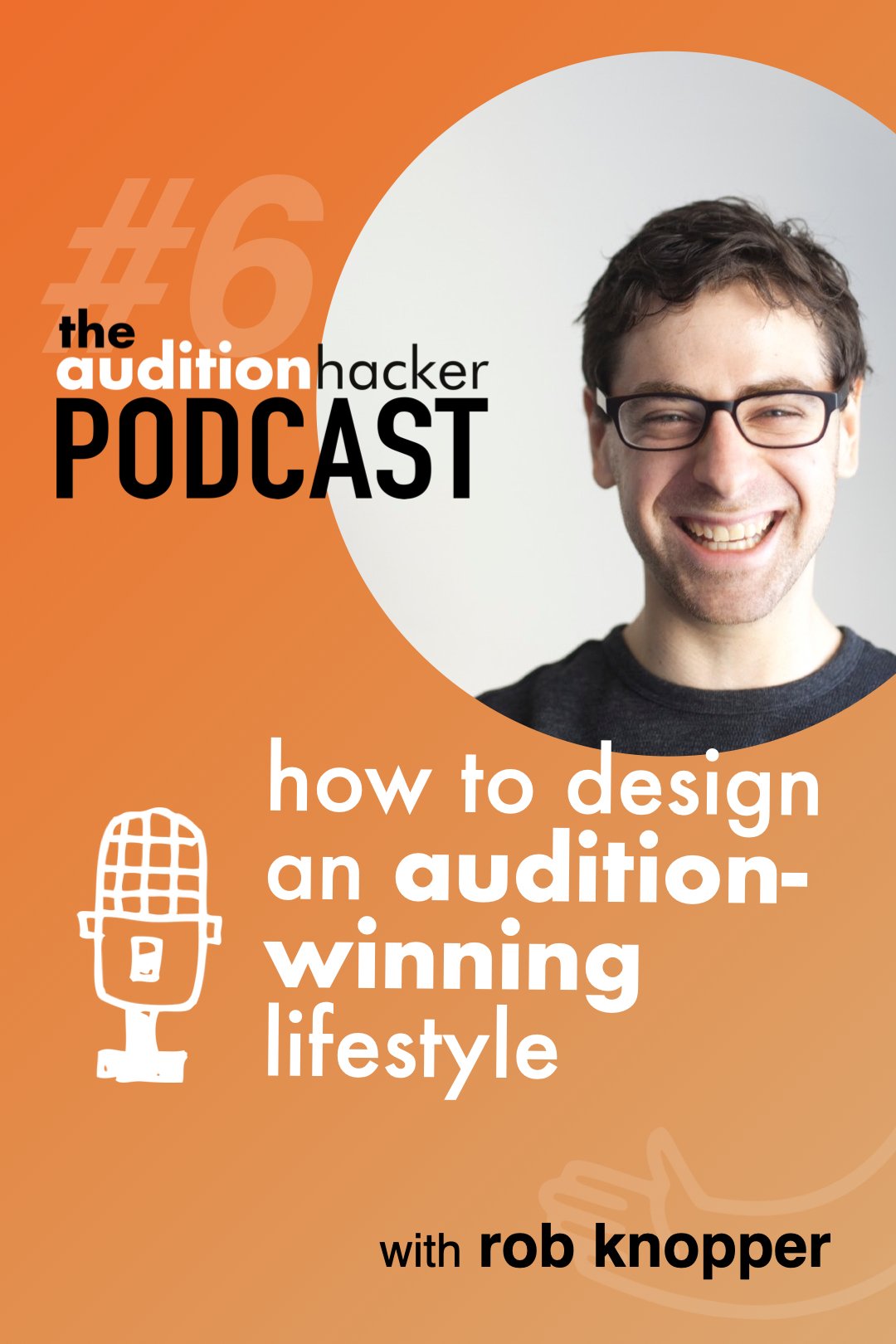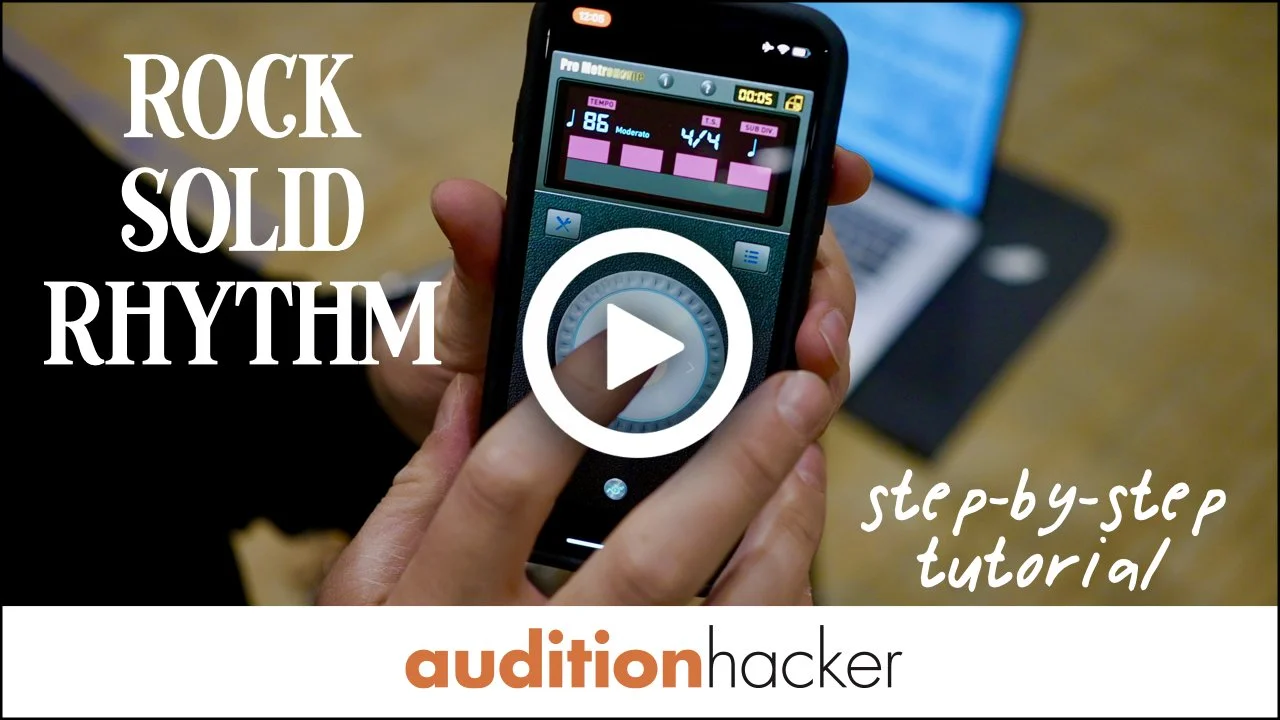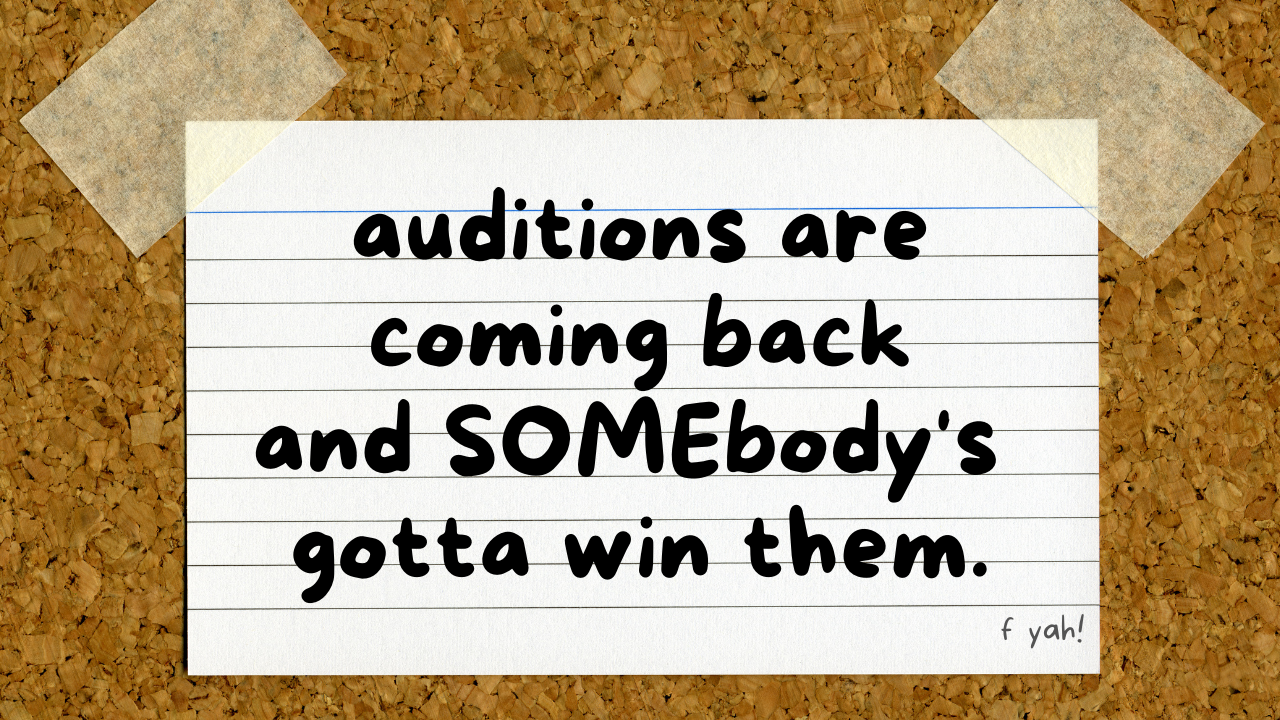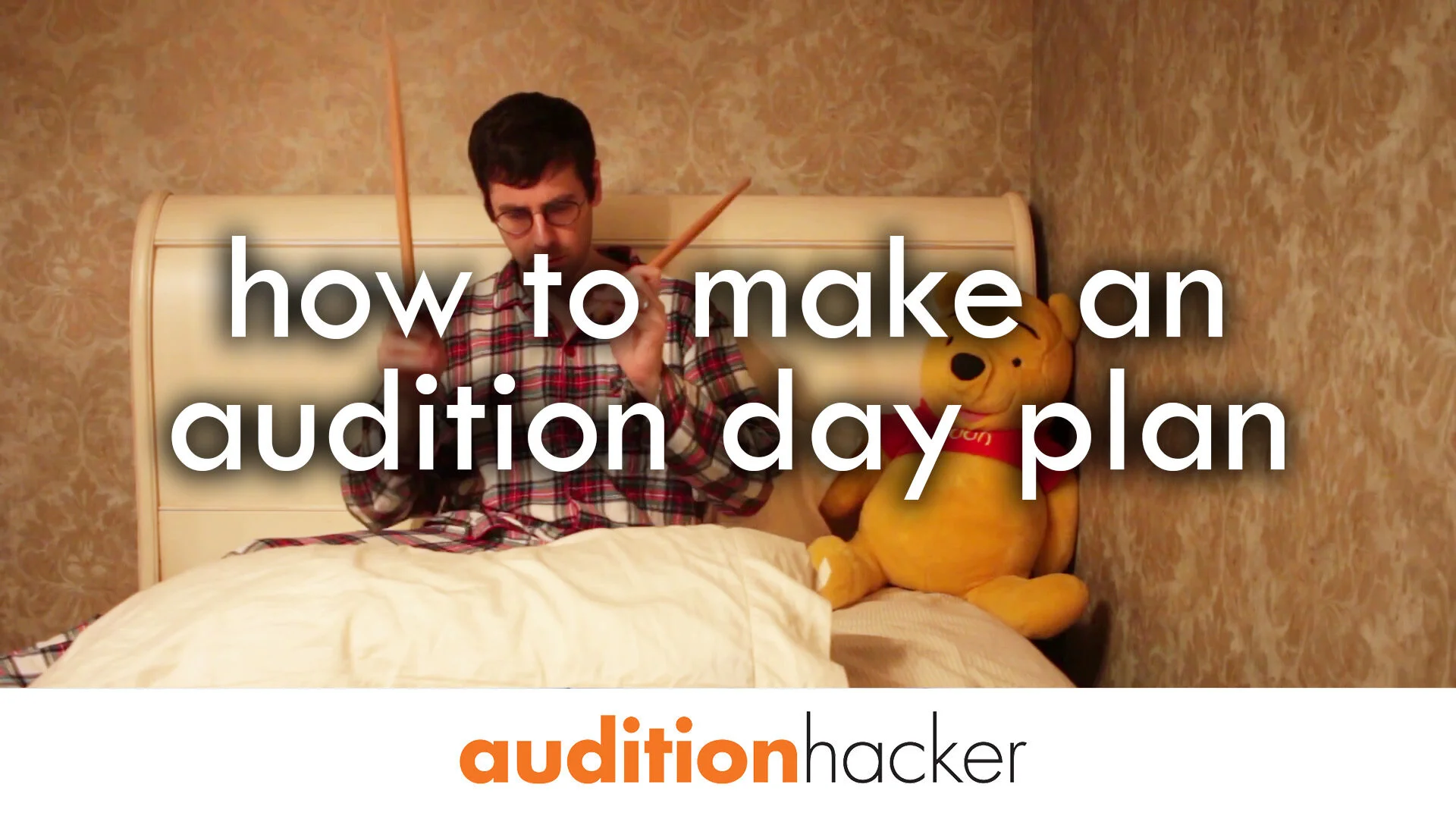it's day 10 of the 12 days of auditions! it's the video series where each day i cover a different topic on how to take auditions. yesterday was day 9: why self-recording is the key to advancing at auditions. make sure to join the auditionhacker facebook group to see the rest of them.
7 months before i won my met orchestra audition, i found myself dumbstruck and surprised in an audition when they asked me to sight read through an excerpt i hadn’t prepared. it was the semi-final round of the milwaukee symphony audition.
all my tambourines, sticks, and music, were laid out nicely on a stick tray and i was standing in front of the vibraphone on the huge stage of the milwaukee performance hall. it was totally silent besides the whooshing air coming from the empty seats of the hall and the scatter of pencils and papers rustling from behind the screen.
i had prepared west side story by bernstein on vibraphone, but i hadn’t prepared this part. they asked for one of the major excerpts, but instead of stopping at the normal ending point, they wanted me to continue reading the next 5 pages of music, arranged on 3 separate stands from the far left to the far right of the vibraphone. i’d never played this part in orchestra.
this was a disaster waiting to happen.
want to learn how to prepare for auditions?
enroll in my new online mini-course, called how to advance in an orchestra audition 101. it's free and it'll be delivered straight to your email starting on november 10th.
and get this: i already made it through the preliminary round, and so the stakes seemed higher. i’d prepared for 3 months, traveled all the way to milwaukee, and advanced once. i have family in milwaukee, and i got their hopes up by sharing with them that i advanced. i didn’t want to waste the achievement of advancing through the first round by blowing it in the second round.
all this was going through my head in the moments before i was asked to play this excerpt at the audition. i knew that i couldn’t perform this piece at its absolute maximum since that would require months of preparation, so i decided to do the one thing that had saved me time and time again: employ my on-the-fly musical skills and sight-read the hell out of it.
i lowered the music so that it was closer to eye-level. i checked all the key signatures. i scanned the music from left to right to see if there were any tempo changes, time signature changes, weird accidentals or rhythmically complex things to look out for, and anything else that could help me in my last-minute performance of this foreign music. i checked the tempo, told myself to be constantly looking ahead, and sung a bit of the music to get the style in my head. and then i, just, started.
sight reading is the invisible skill that prevents us from screwing up, even when we forget to prepare.
it’s the basic musical skill that fills in the gap when there’s just too many things to do. if you get called at the last minute, if you procrastinated too long, or if you just didn’t know you were supposed to be playing until just now, you can sight-read your way through. actually, all your music-making is just a combination of (1.) things you’ve prepared and (2.) things you haven’t. sight reading is your ability to continue to sound like a professional even if you don’t feel like one on the inside. it’s something that you develop over time, but it’s also something that you can actively work on.
ideal preparation vs. what actually happens sometimes
during my crazy undergrad years at juilliard, i had so many things going on. they push you to the actual limit. i had orchestra, chamber ensembles, lessons, mock auditions, performance class, and on top of that i had all my classes like ear training, music history, music theory. and it was all so essential in my development as a musician.
this crazy schedule of constant things happens every single week, one after the other. i don’t remember it slowing down once. and it’ll happen to you in college, too. the hard part isn’t just showing up to all those things, it’s being ready for all those things. and your job is to figure out how to prepare for everything as well as you can.
you *should* be preparing everything at 100%.
but you can’t really give the amount of preparation and focus that each one of those things deserves, because there are just so many important things to work on all the time. and as musicians, we can feel like there’s an endless amount of work to do on each thing before it’s achieved its ideal state of preparedness.
ok, so in your ideal world, everything you do would be completely and utterly prepared, right? if you have a lesson scheduled, you would have practiced 6 hours a day and addressed every problem. if you are starting a new program in orchestra, you’d show up with every note learned, every detail worked out, and you’d have listened to a bunch of recordings. you probably have an ideal preparation for any given playing event that you would want to go through if you had time. and if you haven’t figured out the ideal preparation, that’s something you should be working towards.
but that’s not actually humanly possible.
say that right now in school you have a lesson in 2 days, you have a big part in orchestra coming up, your first rehearsal for a chamber music concert is tomorrow, and you have a composer’s reading happening in 30 minutes. there’s no way you can arrange your schedule so that each of those things gets exactly what it deserves to be the most perfect performance. here’s what happens. you get super nervous and show up with a less-than-ideal state of readiness. that’s ok, because everyone… i mean EVERYONE has been there before. in the normal course of music school events, you’ll end up coming to something without having done that, and in those times you can work on the skill of sight reading. you have to figure out how to present as complete a musical performance as you can, so that you survive your way through the rehearsal without doing too much damage.
if you’re getting stressed out, don’t worry. they keep you busy by design.
you’re going to get better and better by preparing music for different things, and they know that. in fact, they are pushing you to do things faster than you’re comfortable with to push you to get more efficient and effective at the skill of learning music, in part. if you don’t have 6 hours a day for the next 5 days to practice for your lesson, then what will you do? you’ll have to cut something out. you’ll have to experiment with a new, more efficient learning technique. and you’ll have to rely on your basic musical skills to get you through moments that you weren’t able to be fully prepared for. in fact, what you’re learning is that you can do more than you practiced for, and that ability gets better as you improve at the skill set of sight-reading.
sight reading is the skill that gets you through those moments
when you show up to a rehearsal, sight-reading is the skill that bridges the gap between what you already know how to do and what you have to figure out on the fly. it’s the collection of instincts that shows us how to play notes in realtime without ever having looked at them.
sight reading is a skill that allows you to do something new, on the fly, confidently, and musically, without having prepared for it.
it’s the ability to do something unfamiliar without being tripped up.
it’s the combination of musical skills that can be applied, on the fly, to anything.
scale your preparation to the context. what’s left is sight-readable.
basically what you’ve done is you’ve scaled your preparation process to be appropriate for the context. meaning, you've chosen the most important things to practice for, and you've labeled the other things as "sight-readable."
and as you get better and better at sight reading, you’re going to find that there’s more and more things you can trust yourself to do on the fly. what sight reading is doing is improving the list of things that you can do on the fly. your objective is to be able to read through something and be able to present something that sounds rightish. and as you work on this, your level of rightish is going to be better and better over time. so while you’re working on sight reading, the best thing to do is to throw yourself into it. here’s what i mean.
goals of sight reading
1. look like a pro
prepared or not, you have to present yourself as a pro. at some point you’re going to find yourself in a rehearsal for something that you’re prepared very little for. and when this happens, no matter how insecure, scared, or nervous you feel inside, you have to sit down, continue to present yourself as a good, prepared, professional musician, and just survive your way through it. keep your poker face, smile and nod, and don’t let anyone see the turmoil going on inside of you. if people think you might have made a mistake and they look over at you and you look like you’re completely in the zone and nothing bad happened, then they will think that it was them who made the mistake.
2. play as close as possible to the desired result without any preparation
all music is just a combination of elements: rhythm, pitch, dynamics, articulation, tone, phrasing, character, style, etc. you can read rhythms on the fly, right? you can read pitches on the fly as well. sight reading is the ability to read a combination of all of these as successfully as possible. your mission, should you choose to accept it, is to work on all of these separately, together, by yourself, and with others. i’m going to show you a few specific ways to work on this, but for now just know that this is one of your main goals.
3. above all, keep going
the most important thing to do when you’re sightreading is this: KEEP GOING. the worst thing is to stop playing. that’s like falling over on the soccer field and not getting up. everyone falls over at some point or another, but if you stay on the ground then people are going to get concerned and wonder what happened to you. they might come over and pick you up off the field this time, but eventually they’re going to kick you off the team. don’t be that person. get up quickly, and start playing right away like nothing happened. all you can really offer at this point is to read the rhythm, know the time signature, and a few of the pitches. you’re watching the conductor and you’re trying to follow the contour of the line. but sometimes if you start paying attention too closely to the articulations, the slur markings, and some of the more advanced stuff, then your mind is going to wander and you’re going to start messing up the basic stuff like rhythm. this type of behavior is exactly what i’m talking about. the essence of sight reading is the activity of prioritizing what to read if you’re not able to play all of the details that are there.
how to practice sight-reading
you can start here: pick some music up that you’ve never seen before, and put it on the stand. don’t look at it for very long, and play through it. do this over and over and over. give yourself 2 or 3 minutes every day and read through. as you do that, from one day to the next, you’re going to have struggles. at first you’re going to stop mid-piece. and as you try to evaluate your performances, you’ll tell yourself not to stop. and then next time you play, you might completely play the wrong thing but at least you didn’t stop. so that’s an improvement, and you got past step 1 of figuring out how to sight read.
maybe the next day you realize that even though you’re not stopping while you sight read, everything is going wrong. so you heard a tip from somewhere, ‘look ahead while you’re sight reading.’ try looking ahead to the next measure while you’re playing the current measure. try that. see if that improves your sight reading - maybe it does, maybe it doesn’t. as you go through this, try different things. ask your friends for ideas. look online. be creative. it’s your job to put yourself in a sight-reading experience over and over, repetitively, so that you can start adjusting and improving.
and as you do that, notice what things that you're good at, and what have a problem with. those are the things you should focus on, and mull over, and think of ways you can problem solve them. what tip can you plug into your next sight-reading section that can help you improve that time? and if you try something and it does work, keep it forever - write it down. if it doesn’t work, throw it out, or adjust it and try it in a different way.
as you start figuring out which tips apply well to you, start applying those things to those experiences in orchestra or chamber ensemble contexts where you need to call on those skills. maybe looking ahead to the next measure was really helpful for you. start bringing that into orchestra with you. maybe there’s a whole bunch of places in the piece that you studied super hard but you realize that there’s a place you forgot about. your sight reading instinct starts kicking in on the fly. so those are some ways you can start getting good at sight reading. the essence of learning sight-reading is not to be able to pick up new music in your practice room and play it perfectly. it’s to figure out your problems and obstacles when you try to sight-read, and to come up with an approach or a set of solutions to those problems that allows you to overcome those problems. these self-improvement solutions or approaches are things that you can take with you into live chamber music, orchestra, or audition situations.
here are 3 other important things to do when practicing sight reading:
1. do it a lot
like everything else, the more you do it, the better you get. the easier it will be to get a handle on how to approach a section. if last time you forgot to read the key signature, this time you’ll remember. next time you’ll remember how many ledger lines is a G above treble clef after doing it 5 or 6 times. all the things that were uncomfortable the first time will be more comfortable next time, and you’ll feel more confident in the meantime. more repetitive sight reading practice equals more issues worked through and overcome.
2. choose what’s most important and ignore the rest (for now)
in a sight-reading situation, you have to prioritize what to focus on. if the sight-reading tempo is slow enough, you can process and read all the details. you can play the rhythm, pitches, articulations, and you can even consider things like tone, phrasing, and character. as the tempo gets faster, you have to let something go because you can’t process it fast enough. if it gets too extremely fast, you’ll continue having to ignore more elements due to the fact that you can’t process all of the information going by. then the last remaining thing will be rhythm because everything else is out the window.
look at it from the other direction. if you are trying to read and you’re having trouble, start by ignoring everything besides rhythm. once you can successfully read rhythms and ignore the other elements (pitches, etc.). you’ll be playing random pitches, dynamics, and everything else, but the rhythm will be perfect. after you start to play the rhythm with random pitches, and you’re comfortable continuing to read the rhythm in the tempo, try to start following the pitches. to do that, you will have had to look at the key signature so you can play in the right key. you don’t have to follow them all exactly, but try to follow the contour or shape of the pitches. if you end up reading all the rhythms and the pitches without too much stress, then start to notice as many other details as you can - dynamics, phrase markings and slurs, articulations, cues, expression marks, and anything else that you can. as you put yourself in more situations where you’re navigating the ins and outs of prioritizing elements during sight reading, you’ll find that you can evaluate how much you can handle more quickly.
you should ignore some of these elements while sight-reading for practical reasons: your brain can only handle what it can handle, and if you give it too much then it will fail. but the way you choose to prioritize which element to focus on is to make yourself sound as good as you possibly can. when you sight-read, there are certain things that are more likely than not to give away the fact that you aren’t 100% prepared. for instance, if you’re basically playing the rhythms and the right pitches, but you get the dynamic wrong here and there, it’s possible that the conductor won’t notice. and the musicians around you might think that you’re actually playing what’s written, since they probably won’t know your part. depending on the piece, you could possibly even play the wrong pitches, and as long as your rhythm is right then the conductor still won’t notice. you can’t always be at 100% all the time - no one can. nobody’s going to know your part, and it’s your job to fit in as well as you can. find the most important elements in the music and focus on them even if you have to ignore the others, because that will yield the best results in your stage of sight-reading.
3. build your sight-reading skills from the ground up.
isolate elements and work on each one separately.
if you want to dive in and get going, this is a great place to start. for instance, find something to sight read that’s rhythmically complex but has no pitch or very simple pitch variation. Then try sight reading something with complicated pitches and very little rhythmic variation. then work on sight-reading things that have complex articulations or dynamics. start getting used to the feeling of quickly reading these different elements. then try pairing them together. sight-read something and focus on all the rhythms and all the pitches, but just completely ignore the dynamics, phrasing, and everything else. sight-read something and focus on the pitches and dynamics, but ignore the rhythm. continue building these until you get so comfortable with the elements that you can read 3 at a time. then 4. here’s what i mean:
if you were playing the william tell overture violin part on your instrument and all you had to do was play each pitch for one eighth note, then sight reading would be easier than if you were also reading the rhythm. this is a way to approach sight-reading from a different angle than just trying to do everything at once. as you work on these isolated elements, remember to always bring them together and sight read a full piece that you’ve never looked at before.
4. here are some places to find sight reading material
orchestra parts of different instruments that you can read on your instrument.
if you’re playing shostakovich 5 and you play oboe, then go get the violin part and sight read that, because you kind of know how it should go but you’ve never looked at it before.
get an etude book of another instrument.
open an etude book for your instrument that you’ve never looked at before.
start seeing everything on your music shelf as possible sight reading opportunities.
scour IMSLP for sight reading.
conclusion
sight-reading is your basic level of musicianship.
everything that you prepare is just a bonus. think of your sight-reading level is your new base-level of playing. it’s the worst that you can be. when you work on sight-reading, you improve the lowest level of your playing to something that’s professional and ready to put into action in any situation. you should work on sight-reading so that you can feel confident that your lowest level of playing is acceptable to you to bring to professional situations.
however, it’s not a replacement for true preparation of music.
unfortunately, even the best sight-readers will never be able to reach their own personal potential by being great at sight reading. that story i told about my excerpt in the milwaukee symphony? i thought it went really well…for sight reading. i didn’t advance, and i’m sure it’s partially due to the fact that the panel was used to hearing high quality, detail-oriented performances. and although mine may have been in rhythm and with the right pitches for the most part, it was still missing many little details that would have been worked out through a more meticulous preparation.
see you tomorrow! we'll be talking about beta-blockers.












in 2019, a cellist named maria reached out to me about her audition struggles. on paper, she was the “worst audition candidate ever” (her words). she had 2 small children, a full-time teaching job, and hadn’t taken an audition in 4 years.